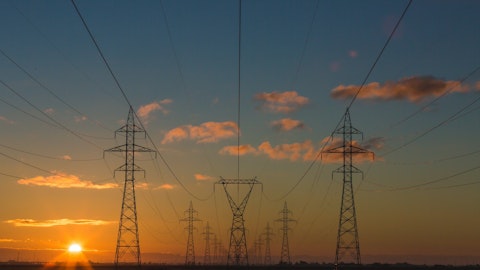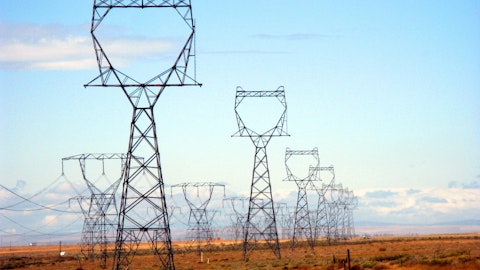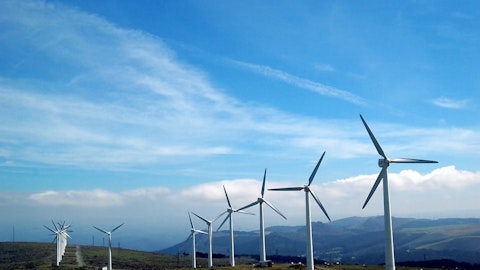Bob Frenzel: Yes. Consistent with past practice Nick, we would expect some forms of customer protection, capital costs or energy cost providers. We’ve submitted some proposals to the commission that they – so they are purview. It will go along with their overall decision. And on the portfolio side, of course there’s always a chance to look at it, but we’ve looked at this sideways, back ways, front ways. I think we’ve put together a great plan that complements the geographic diversity in the state where the wind and solar physically come into the grid to provide high resiliency and reliability from the renewable resources. And so always a chance to move it around a little bit, but we’ll think the substantial changes coming from the plan.
Nicholas Campanella: That’s great and if I could just squeeze one more in. You talked about the Data Centers in your prepared remarks, your weather-normalized load for 2024 is 2% to 3% and that’s higher than last year by 100 basis points. So just — what are you seeing that’s changing the demand profile? Or how are you thinking about the longer-term forecast? And whether that’s pressure higher in your 5% to 7%? Thank you.
Brian Van Abel: Thanks Nick. I’ll take that one. The way I think about it is — yes. So we’re starting to see a number of things in our long-term sales forecast. We updated our sales forecast for 2024, 2% to 3%. But we think over the five years at that 2% to 3% CAGR to hold, if not call it conservative given what we’re seeing on the potential load from data centers. Data centers represent less than 1% of our sales right now. We see some potential where that could grow to 5% over this next five years. As I think about just next year significant electrification happening in the oil and gas region in the Permian Basin the Delaware Basin. We’re working very closely with our large customers down there around — it’s not just — it’s not really about even more drilling.
It’s electrification of their pumps compressors as they hit their net zero goals in the Permian Basin and achieve the goals that the state of New Mexico has for them. And then also we’re starting to see an up-tick in residential demand. We’re starting to see penetration from the EV perspective. So overall really great trends as we look out — not only next year, but longer term with kind of electrification and data center potential.
Bob Frenzel: Hey Nick, just to add on to that. This is Bob. When I think about some of the comments I made in the opening remarks, about the ability to deliver clean energy more cost effectively in our regions of the country than other parts. I think over the long-term that should absolutely accrue to our state’s benefits in terms of economic development. Energy and energy-intensive resources are going to come back in onshore in the United States. We should be a very attractive destination for them, as we can deliver renewable energy and clean energy much more cost effectively. We serve customers where the wind blows and the sun shines and that translates to high capacity factors and lower energy cost to our customers which should lead to long-term economic development in our states.
Nicholas Campanella: All right. Thanks so much. See in a few weeks there.
Operator: Thank you very much sir. We’ll now move to Durgesh Chopra coming from Evercore ISI. Please go ahead.
Durgesh Chopra: Hey good morning team. Thanks for taking my questions.
Brian Van Abel: Hey. Good morning.
Durgesh Chopra: Good morning. You guys have been sort of the leader in transferability. I mean you were kind of one of the first ones to introduce the concept and start working on it. It seems like you’re making great strides here. The target for the year, if I recall this if I have this correctly it was increased from $200 million to $300 million to $400 million. I just wanted to see, if I’m thinking about that correctly. And then, what does that do to the power plant had $1.8 billion in total amount raised from transferability? What does that number look like in the current plan?
Brian Van Abel: Yeah. So you’re actually thinking about it correctly. When we went into this year before the market has even fully set up, we’re a little bit conservative in saying around $200 million. We’ve already executed two contracts for $250 million and working on another. So we feel very good about our $300 million to $400 million for — in total for the balance of the year. And when we think about our baseline we’ve layered in the solar projects now that they’ve been approved. So we have a little bit over about $500 million run rate annual transfer of PTC credits. So it’s about a total of $2.7 billion over our five-year forecast from 2024 to 2028.
Durgesh Chopra: Thank you. That’s really helpful. And then maybe just — I didn’t see this in your prepared remarks on slide deck, maybe I missed it. But just any update on the gas price risk management plan that you have to file in Colorado? I believe that’s due next month.
Brian Van Abel: Yeah. So we’ll file it by November 1st, absolutely right. So due next week we’re working with the stakeholders, we’re working on the plan and we’ve seen compounded in a couple of different veins. One is this idea of the smoothing mechanism where we can reduce volatility by using our balance sheet. And so if commodity prices spike to a certain level, we would take that on our balance sheet and spread over one, two, three, four years and get a carrying cost on it or really reduce that volatility that our customers experienced last year. So that’s important because we need to maintain a good balance sheet, strong product quality to be able to use our balance sheet to help our customers out. The second part is really focused on what are the proposals we can make to reduce volatility and that’s whether there’s additional physical storage, potential for fixed physical contracts or additional financial hedging.
So you see all out of par proposal here coming up next week and look forward to working with the commission and the stakeholders and helping reduce the volatility for our customers in Colorado.
Bob Frenzel: Durgesh just to add on to that, one of the best things we’ve done for our customers is our renewables portfolio. We have lowered our reliability on fossil fuels dramatically over the past five years and the customers have accrued over $4 billion of fuel savings and tax benefits from that since 2017. So as we continue to look forward obviously the Colorado Energy Plan our Upper Midwest Energy plans certainly derisk our customers from a commodity volatility on the electric side. And as we lean into clean fuels, you start to see that on the gas LDC side as well.
Brian Van Abel: And just to clarify, we meant that we’ve reduced our reliance on fossil fuels not the reliability of our fossil fuels [ph].
Durgesh Chopra: Yeah, yeah. Thanks team for that color. Really appreciate it.
Operator: Thank you sir. We’ll now move to Carly Davenport of Goldman Sachs. Please go ahead.




